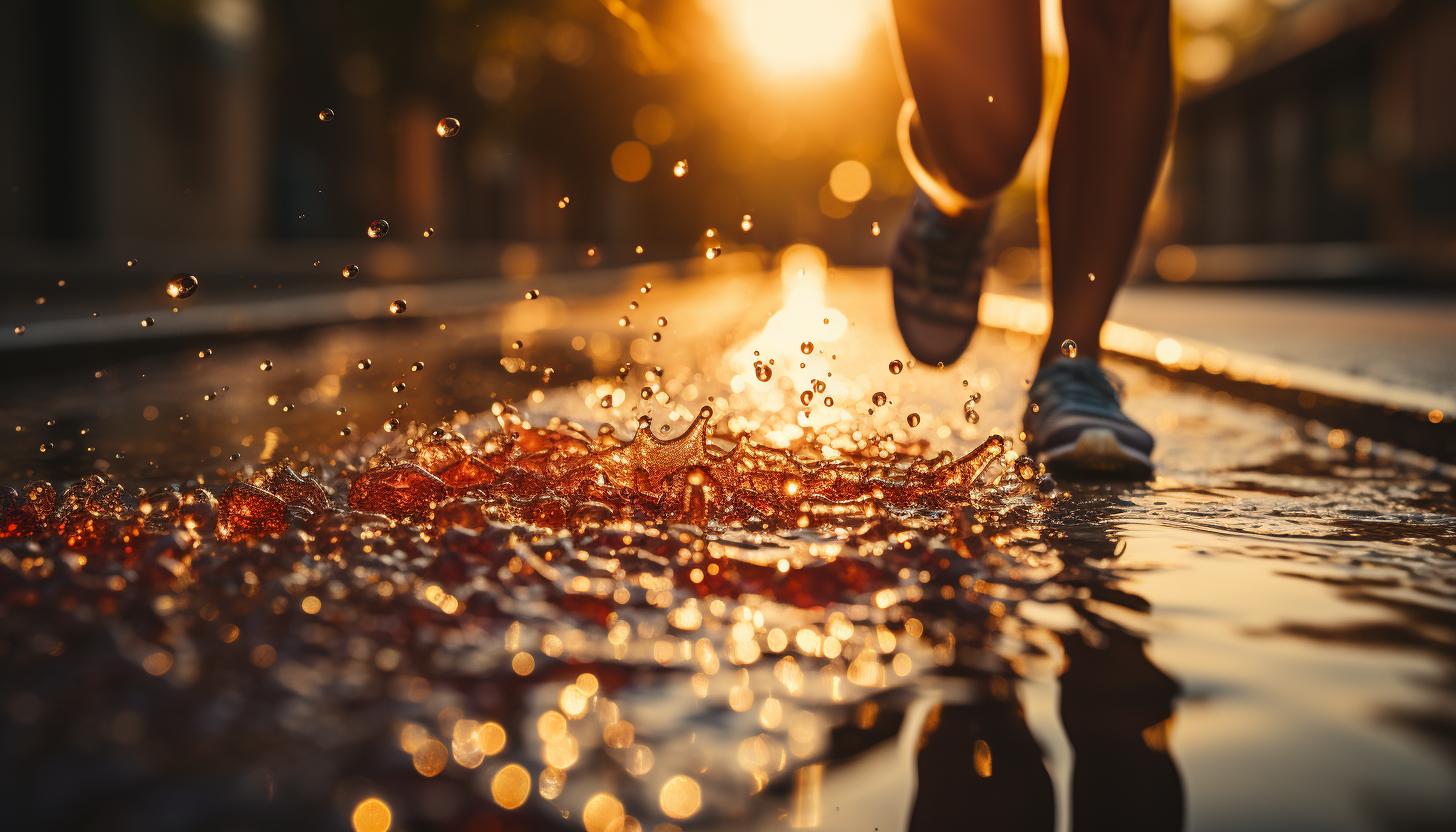Hydration Packs Vs. Water Bottles: Staying Hydrated on Hot Runs

Are you tired of feeling like a wilted flower on your hot runs? Stay hydrated and refreshed with the ultimate battle between hydration packs and water bottles.
Dive into this informative article where we explore the pros and cons of each, helping you choose the perfect hydration system for your needs.
With expert tips on proper hydration and maintenance, you’ll be ready to conquer any scorching run that comes your way.
So grab a cold drink, sit back, and let’s quench our thirst for knowledge!
Pros and Cons of Hydration Packs

There are some pros and cons to using hydration packs for staying hydrated on hot runs.
Hydration packs offer both comfort and convenience. With a hydration pack, you don’t have to worry about holding a water bottle in your hand or wearing a belt with multiple bottles. The pack sits comfortably on your back, distributing the weight evenly, allowing for a more natural running motion.
In terms of storage capacity, hydration packs typically have larger reservoirs than water bottles, ranging from 1.5 to 3 liters. This means you can carry more water with you without having to stop frequently to refill.
However, there are also limitations to using hydration packs. The larger size and increased weight of the pack can be cumbersome, especially during shorter runs where less water is needed. Moreover, the hose and bite valve system can sometimes be difficult to clean properly. Additionally, it may take some time to get used to drinking from the hose while running without breaking stride.
Despite these limitations, hydration packs offer great advantages in terms of comfort and storage capacity compared to water bottles. However, if you prefer something more lightweight or don’t require as much water during your runs, then water bottles might be a better option for you.
Benefits and Limitations of Water Bottles

To keep yourself refreshed during your intense workouts, it’s important to consider the advantages and drawbacks of using water bottles.
Water bottles offer several benefits when it comes to staying hydrated on hot runs. First and foremost, they are portable and easy to carry. You can simply grab a water bottle and head out for your run without any hassle. Additionally, water bottles are readily available and can be refilled easily at water fountains or sinks along your route.
Another advantage of using water bottles is that they come in various sizes, allowing you to choose the amount of hydration you need based on the duration and intensity of your workout. This flexibility ensures that you have enough water to keep you going throughout your run.
However, there are also some limitations to using water bottles. One major drawback is that carrying a bottle in your hand can be cumbersome during longer runs or intense workouts. It may disrupt your natural running form or cause discomfort.
Moreover, if you’re relying solely on a single water bottle for hydration during a longer run, you may run out of fluids before reaching a refill point. This could lead to dehydration or force you to cut short your workout.
Choosing the Right Hydration System for Your Needs

When choosing the right hydration system for your needs, it’s important to consider factors such as comfort and capacity. Staying hydrated during hot runs is crucial for maintaining performance and preventing dehydration. Here are three key factors to consider when deciding between a hydration pack and a handheld bottle:
– Convenience: A handheld bottle offers easy access to water without the need to stop or remove any gear. It allows you to quickly hydrate on the go, making it ideal for shorter runs or races where frequent sips are sufficient. On the other hand, a hydration pack provides hands-free convenience by distributing weight evenly across your back, allowing for longer distances without interruptions.
– Capacity: The size of your runs will determine how much water you need to carry. Handheld bottles typically hold between 8-20 ounces of fluid, while hydration packs can range from 1-3 liters. If you’re going on longer runs or prefer not to refill frequently, a hydration pack with a larger capacity might be more suitable.
– Comfort: Consider how each option feels while running. Handheld bottles come with straps that help secure them in your hand, but some runners may find them uncomfortable over extended periods due to grip fatigue. Hydration packs offer adjustable straps and padded back panels for added comfort and stability.
Tips for Proper Hydration on Hot Runs

Make sure you replenish your fluids frequently to avoid dehydration during your runs in the heat. Hydration is of utmost importance when it comes to running in hot weather. Not only does proper hydration help maintain your performance, but it also prevents overheating and reduces the risk of heat-related illnesses.
Here are some strategies you can use to ensure you stay properly hydrated during your hot runs:
| Strategy | Description |
|---|---|
| Drink water before, during, and after your run | Start hydrating well before your run and continue drinking fluids throughout. Aim for at least 8-10 ounces of water every 15-20 minutes during exercise. Afterward, replace any lost fluids by drinking more water or a sports drink with electrolytes. |
| Monitor urine color | Check the color of your urine to gauge your hydration level. Pale yellow indicates proper hydration, while dark yellow suggests dehydration. Aim for light-colored urine throughout the day. |
| Choose electrolyte-rich drinks | When exercising intensely or for extended periods, consider consuming sports drinks that contain electrolytes like sodium and potassium to replenish what you’ve lost through sweat. These help maintain fluid balance and prevent muscle cramps. |
| Plan routes near water sources | If possible, plan your running routes around areas where you have access to water fountains or convenience stores so that you can easily refill your supplies as needed. |
Maintenance and Care for Hydration Packs and Water Bottles

Don’t forget to regularly clean and sanitize your hydration gear, such as your pack or water bottle, to ensure that you’re maintaining proper hygiene while staying hydrated on your runs. Neglecting to clean these items can lead to the growth of bacteria and mold, which can cause unpleasant odors and potentially make you sick.
Here are some cleaning techniques and storage solutions for your hydration gear:
– Cleaning Techniques:
– Use warm soapy water: Start by rinsing out your hydration pack or water bottle with warm water. Then, add a small amount of dish soap and scrub the inside thoroughly.
– Utilize a cleaning brush: For hard-to-reach areas, like the narrow opening of a water bottle or the tube of a hydration pack, use a specialized cleaning brush to remove any buildup.
– Rinse thoroughly: After washing, make sure to rinse all soap residue from your gear using clean running water.
– Storage Solutions:
– Allow for air drying: After cleaning, ensure that your hydration gear is completely dry before storing it. Leave the lids off and let them air dry in a well-ventilated area.
– Store in a cool place: Avoid storing your hydration packs or bottles in direct sunlight or hot environments as this can accelerate bacterial growth.
– Consider using storage bags: To protect against dust and potential contamination when not in use, store your cleaned hydration gear in designated storage bags.
Conclusion
In conclusion, when it comes to staying hydrated on hot runs, the choice between hydration packs and water bottles ultimately depends on your individual needs and preferences.
Both options have their pros and cons, but symbolism can be found in the way they represent our commitment to taking care of ourselves.
Whether you opt for the convenience and capacity of a hydration pack or the simplicity of a water bottle, remember to prioritize proper hydration.
Make sure to choose a system that suits you best and take good care of it for optimum performance.
Stay cool, stay hydrated!






